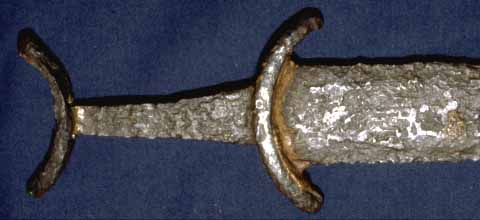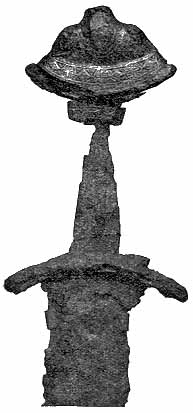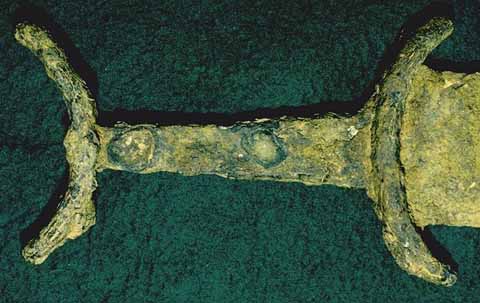

 The photograph above is of the less
cleaned side of this sword. The hilt retains only the unadorned iron upper
and lower guards characteristic of Petersen's type L; the pommel has been
lost. The upper guard is in the form a curved elongated elliptical slotted
plate. The slot is longer on the side of the upper guard facing the pommel.
The tang passes through the center of the slot and has been upset (widened)
at its end to fix the upper guard in place. The pommel would have been attached
to the upper guard as a cap, either by means of rivets or adhesives. The
crossguard (lower guard) is similarly curved, toward rather than away from
the blade, and is somewhat wider than the upper guard.
The photograph above is of the less
cleaned side of this sword. The hilt retains only the unadorned iron upper
and lower guards characteristic of Petersen's type L; the pommel has been
lost. The upper guard is in the form a curved elongated elliptical slotted
plate. The slot is longer on the side of the upper guard facing the pommel.
The tang passes through the center of the slot and has been upset (widened)
at its end to fix the upper guard in place. The pommel would have been attached
to the upper guard as a cap, either by means of rivets or adhesives. The
crossguard (lower guard) is similarly curved, toward rather than away from
the blade, and is somewhat wider than the upper guard.
The illustration to the left is fig. 94 from Petersen (1919), showing an example of a type L sword found in Norway, where the most documented type L swords have been found. The pommels generally have three lobes, though examples with five lobes are known, with the central lobe being the most prominent. The pommel and grip ferrules characteristically have silver or silver and niello decoration. In some examples, the nature of this decoration, referred to as the Trewhiddle style, is favored to be of British Anglo-Saxon origin rather than Scandinavian, with many examples found in Norway thus being regarded as of British origin.
Another especially splendid example of a type L sword was found in 1976
in the village of Gilling West, N. Yorkshire, England, and is now in the
Yorkshire museum in York, England, accession 1979.81. According to Watkin (1986) the decoration
on the pommel is of silver with contrasting niello inlay, as are five ferrules
(bands) around the [now absent] grip. The blade is described as pattern-welded
with three bands of alternating twisted and straight pattern on each face
of the blade.
 A further example of a sword of this
type, illustrated to the right, similar to our present example in that the
pommel and all decoration have perished, was found near Bruton, Somerset,
England in the early 1980s and is presently in the Somerset County Museum.
This sword sold at Christie's London as lot 70 on July 25, 1984 for £1,944.
A further example of a sword of this
type, illustrated to the right, similar to our present example in that the
pommel and all decoration have perished, was found near Bruton, Somerset,
England in the early 1980s and is presently in the Somerset County Museum.
This sword sold at Christie's London as lot 70 on July 25, 1984 for £1,944.